BRUGERMANUAL
BEDIENUNGSANLEITUNG
USER
MANUAL
MANUEL D’UTILISATEUR
BRUKERVEILEDNING
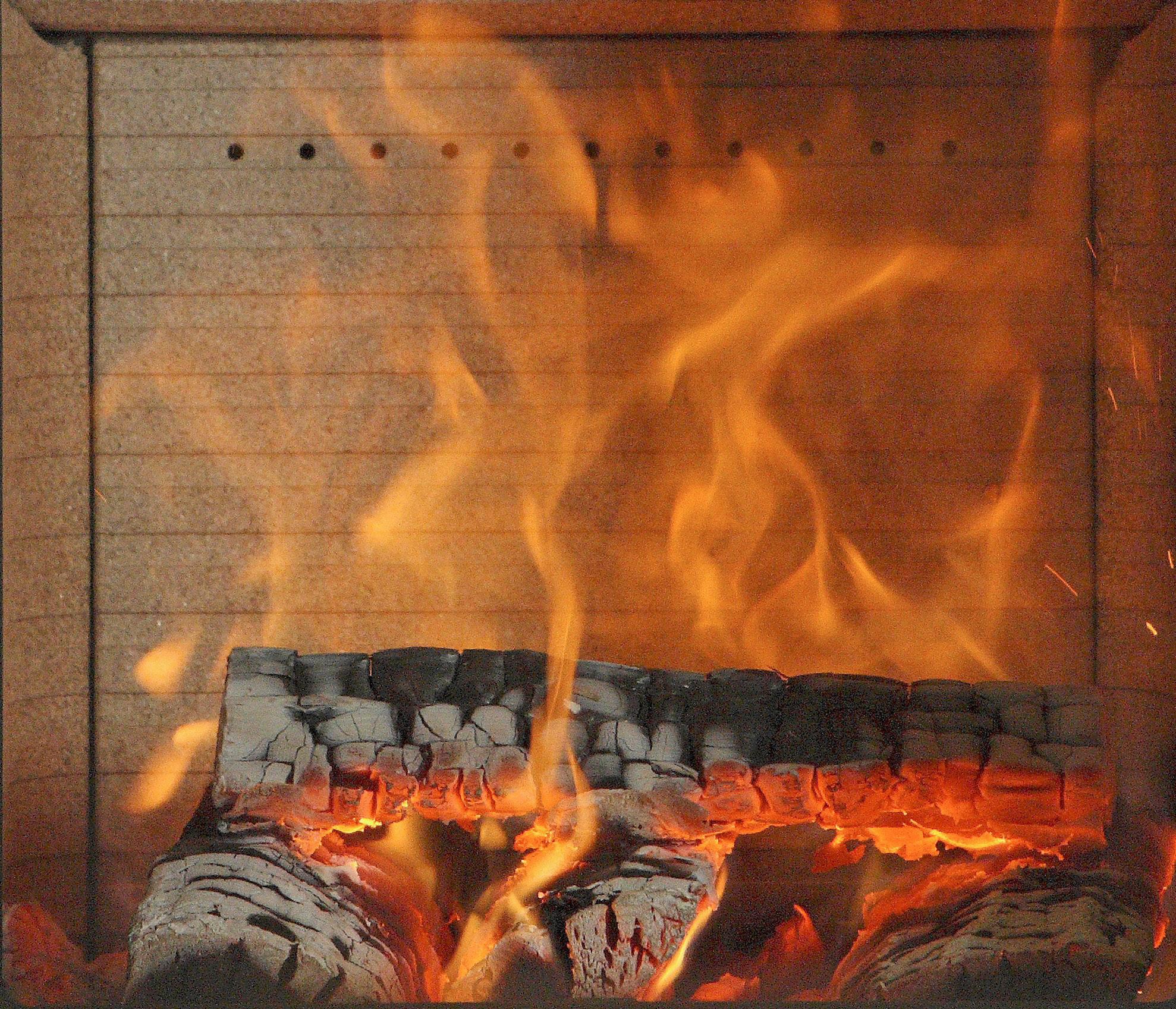
BRUKSANVISNING
KÄYTTÖOHJE
GEBRUIKERSHANDLEIDING
VISIO 2-1
Mærkeplade/CE Zeichen/Manufacturer’s plate/Plaque signalétique/Merkeplate/Märkplät Norge, England
16
EN 13229:2001+A1:2003+A2:2004,
EC.NO: 225
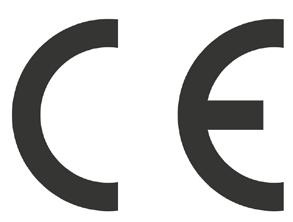
Notified Body: 1235
Produced at:
RAIS A/S, Industrivej 20, 9900 Frederikshavn, Danmark
Visio 2-1 NS
Anordningen må kun installeres i forbindelse med ubrændbart materiale.
AFSTAND TIL BRÆNDBART, BAGVÆG
ABSTAND ZU BRENNBAREN BAUTEILEN, HINTEN
DISTANCE TO COMBUSTIBLE BACK WALL
DIST. ENTRE COMPOSANTS COMBUSTIBLES, ARRIÈRE
AFSTAND TIL BRÆNDBART, SIDEVÆG
ABSTAND ZU BRENNBAREN BAUTEILEN, SEITE
DISTANCE TO COMBUSTIBLE SIDE WALL
DISTANCE ENTRE COMPOSANTS COMBUSTIBLES, COTÉ
AFSTAND TIL BRÆNDBART, MØBLERING
ABSTAND VORNE ZU BRENNBAREN MÖBELN
DISTANCE TO FURNITURE AT THE FRONT
DISTANCE ENTRE COMPOSANTS COMBUSTIBLES, DEVANT
CO EMISSION (REL. 13% O2)
CO EMISSION IN DEN VERBRENNUNGSPRODUKTEN (BEI 13%O2)
EMISSION OF CO IN COMBUSTION PRODUCTS (AT 13%O2)
EMISSION CO DANS LES PRODUITS COMBUSTIBLES (À 13%O2)
PARTIKLER / PARTIKELN / PARTICLES / PARTICULES:
STØV / STAUB / DUST / POUSSIÈRES:
RØGGASTEMPERATUR / ABGASTEMPERATUR / FLUE GAS TEMPERATURE / TEMPÉRATURE DES GAZ DE FUMÉE:
NOMINEL EFFEKT / HEIZLEISTUNG /
THERMAL OUTPUT / PUISSANCE CALORIFIQUE:
VIRKNINGSGRAD / ENERGIEEFFIZIENZ / ENERGY EFFIENCY /EFFICACITÉ ÉNERGÉTIQUE:
DK: Brug kun anbefalede brændsler. Følg instrukserne i bruger manualen. Anordningen er egnet til røggassamleledning og intervalfyring.
DE: Lesen und befolgen Sie die Bedienungsanleitung.
Zeitbrandfeuerstätte. Nur empfohlene Brennstoffe einsetzen.
UK: Fuel types (only recommended). Follow the installation and operating instruction manual. Intermittent operation.
F: Veuillez lire et observer les instructions du mode d’emploi. Foyer à durèe de combustion limitèe, homologué pour cheminée à connexions multiples. Utiliser seulement les combustibles recommandés.
Produced for:
ATTIKA FEUER AG, Brunnmatt 16, CH-6330 Cham / RAIS A/S, Industrivej 20, DK-9900 Frederikshavn
Label for: RAIS Visio
DK: mm SE BRUGERVEJLEDNING
DE: mm SIEHE BEDIENUNGSANLEITUNG
UK: mm SEE USER MANUAL
FR: mm CONSULTEZ LE GUIDE DE L’UTILISATEUR
DK: mm SE BRUGERVEJLEDNING
DE: mm SIEHE BEDIENUNGSANLEITUNG
UK: mm SEE USER MANUAL
FR: mm CONSULTEZ LE GUIDE DE L’UTILISATEUR
DK: 1200mm SE BRUGERVEJLEDNING
DE: 1200mm SIEHE BEDIENUNGSANLEITUNG
UK: 1200mm SEE USER MANUAL
FR: 1200mm CONSULTEZ LE GUIDE DE L’UTILISATEUR
0,2203 % / 2754 mg/Nm³
3,59 g/kg 26 mg/Nm³ 207 °C
5,8 kW 79 %
DK: BRÆNDE
DE: HOLZ
UK: WOOD
FR: BOIS
Raumheizer für feste Brennstoffe
Appliance fired by wood
Poêle pour combustibles solides
Reference / DTI test report:
300-ELAB-2241-EN
300-ELAB-2241-NS
300-ELAB-2241-AEA
Not to be used in a shared flue
RAIS/attika VISIO 2-1
Mærkeplade/CE Zeichen/Manufacturer’s plate/Plaque signalétique/Merkeplate/Märkplät
Danmark, Deutschland, France
Prod uced at:
RAIS A/S, Indus trivej 20, 9900 Frederikshavn, Danmark
EN 13229:2001+ A1:2003+A2:2004
EC.NO: 226
16
VISIO 2-1 DIN +
Raumheizer für feste Brenn stoffe App lian ce fi red by wood Poêle pou r combu stibl es solides
An ord nin gen må kun installeres i forbindelse med ubrændbart mat eriale.
AF STA ND TIL BRÆNDBART, BAG VÆG
AB STAND ZU BRENN BAR EN BAUTEILEN, HINTEN
DISTANCE TO COMBUST IBL E BAC K WA LL
DIST. ENT RE COMPOSANTS C OMBUSTIBL ES, ARR IÈRE
AF STA ND TIL BRÆNDBART, SID EVÆG
AB STAND ZU BRENN BAR EN BAUTEILEN, SEIT E
DISTANCE TO COMBUST IBL E SIDE W ALL
DISTANCE ENT RE COMPO SAN TS COMBUSTIBLES, CO TÉ
AF STA ND TIL BRÆNDBART, MØBLERING
AB STAND VO RNE ZU BRENNBAREN MÖB ELN
DISTANCE TO FURNITURE A T THE F RONT
DISTANCE ENT RE COMPO SAN TS COMBUSTIBLES, DEVANT
CO EMISSION
CO EMISSION IN DEN VERBR ENNUNG SPRODUKTEN
EMISSION OF CO IN C OMBUST IO N PRODU CT S
EMISSION CO DANS LES PRO DUITS C OMBUST IBL ES
STØV / ST AUB / DU ST / PO USSIÈR ES:
DK: SE BRUGERVEJLEDNING
DE: SIEHE B EDIENU NG SANLEITUNG
UK: SEE USER MA NUA L
FR: CO NSULT EZ L E GU IDE DE L'U TILISAT EUR
DK: SE BRUGERVEJLEDN ING
DE: SIEHE BEDIENUNG SANLEITUNG
UK: SEE U SER MAN UAL
FR: CO NSULTEZ LE GUIDE DE L'UT IL ISAT EUR
DK: Visio 2-1: 1200mm
DE: Visio 2-1: 1200mm
UK: Visio 2-1: 1200mm
FR: Visio 2-1: 1200mm
DK: 0,071%
DE: 0,071% / 888 m g/Nm3
UK: 0,071%
FR : 0,071%
DK: 24 mg/Nm3 / DE: 24 mg/N m3
UK: 24 mg/Nm3 / FR: 24 mg/Nm3
RØ GG ASTEMPERATUR / ABG AST EMPERATUR / F LUE GA S TEMPERATURE / T EMPÉRATURE DES GAZ DE FUMÉE:
NO MIN EL EF FEK T / H EIZL EISTUNG / T HERMAL OUT PUT / PUISSANCE CALOR IFIQ UE:
VIRKNINGSGRAD / ENERGIEEF FIZIENZ / ENER GY EFFIENCY /EFFICACITÉ ÉNERGÉTIQU E:
DK: Brug kun an befalede brænds le r Følg ins truksern e i bru germ anualen Anordningen er egnet til røgga ssa ml el ed ning o g interv al fyring
DE: L esen und bef olgen Sie die Be dienungsa nle it ung Z ei tbran dfeuers tät te. Nu r empf ohlene Brenn st off e ei nset ze n.
UK: Fuel ty pes (o nly re co mmended) . Follow the i nstallation an d o peratin g instruc tion ma nual Intermi ttent op eration
F : Veuil le z lire e t observer les instructions du mode d'emploi
F oyer à d urèe de co mbu stion lim it èe, hom olog ué po ur chemi née à con nexions m ultiples Utiliser seulem en t les comb ustibles re co mmandés
Hergestellt für /Produced fo r:
DK: 256°C / DE: 256°C
UK: 256°C / FR: 256°C
DK: 8,6 kW / DE: 8,6 kW
UK: 8,6 kW / FR: 8,6 kW
DK: 80% / DE: 80%
UK: 80% / FR: 80%
DK: BR ÆNDE
DE: HO LZ
UK: W OO D
FR : B OIS
ATTIKA F EUER AG, Brunnmatt 16, CH-6330 Cham / RAIS A/S, Industrivej 20, DK-9900 Frederikshavn
15a B-VG
Referen ce / DTI test report:
300-EL AB-2241- EN
300-EL AB-2241- DIN +
300-EL AB-2241- AUS
Typ F CXX xFCXXxReservedelstegning / Ersatzteilzeichnung / Spare parts drawing / Dessin des pièces de rechange / Reservdelsritning
Indstilling af spjæld / Einstellung der Luftklappe / Adjustment of the air damper / Réglage du volet d’air / Innstilling av spjeldet / Inställning av spjället
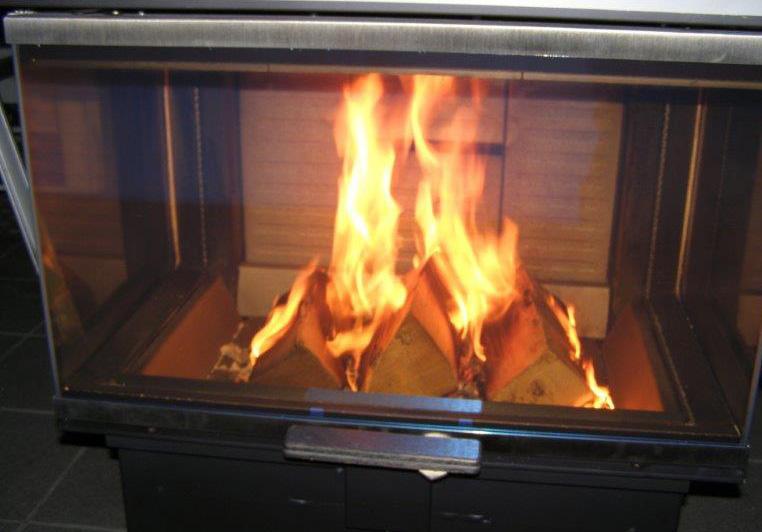
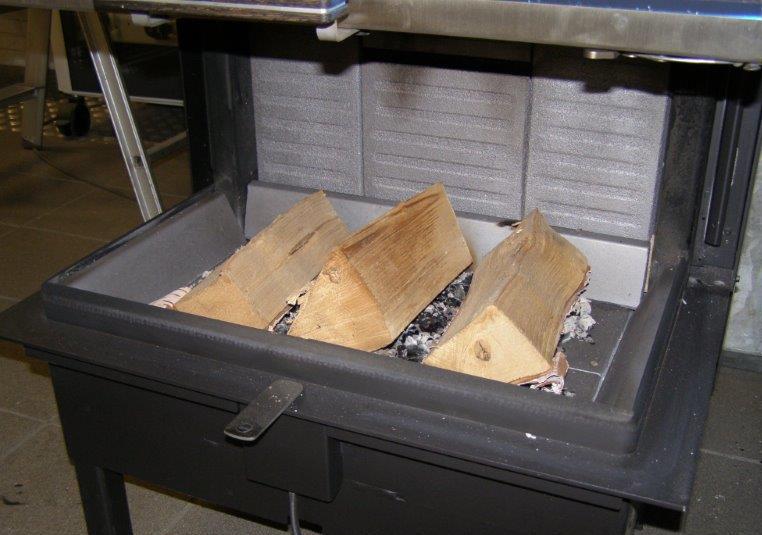

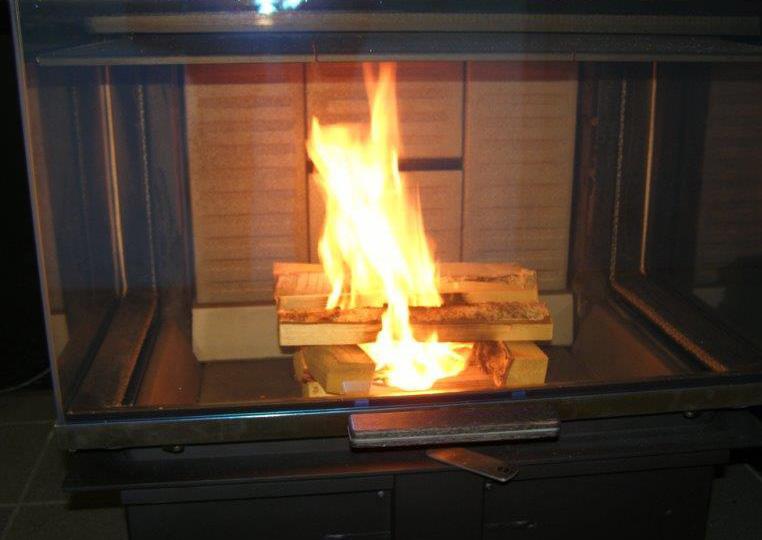
Position 1 - Posisjion 1
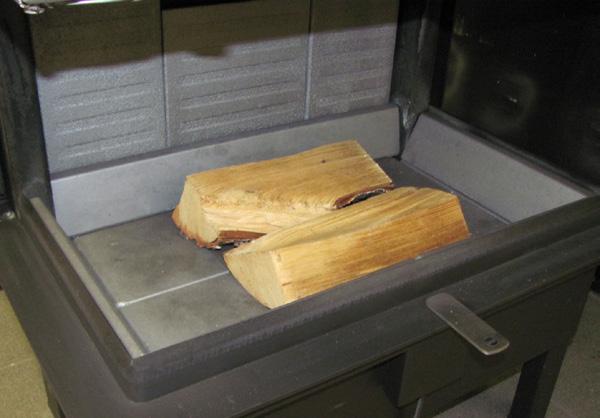

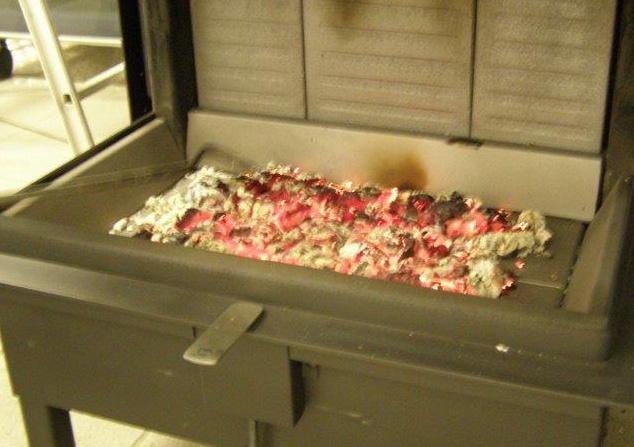
Position 2 - Posisjion 2
Position 3 - Posisjion 3
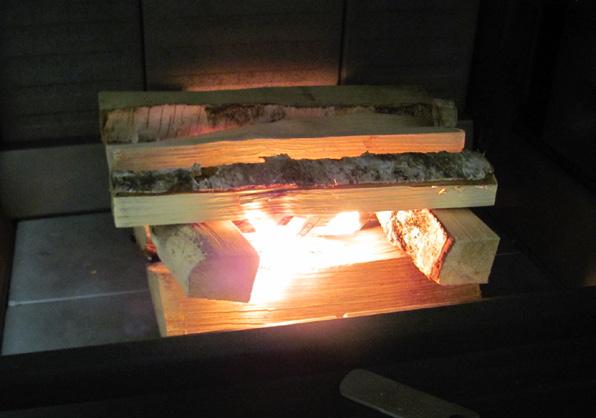
Optænding og påfyldning / Anzünden und Nachlegen / Lighting and fuelling / Allumage et remplissage / Opptenning og påfylling / Upptänding och påfyllning
VISIO 3 positioner af spjældhåndtag
VISIO 3 positioner af spjældhån
VISIO 3 positioner af spjældhåndta
FIRE ENVIRONMENTALLY FRIENDLY!
5 Eco-friendly advices for sensible heating - common sense both environmentally and economically.
1. Effective lighting. Use small pieces of wood (fir tree) and a suitable fire lighter, for example paraffined wood wool/sawdust. Open the air damper, so plenty of air is fed to the stove and the gases from the heated wood can burn rapidly.
2. Light the fire with only little wood at a time - this gives the best combustion. Remember plenty of air for every time new wood is added.
3. When the flames are diminished, adjust the air damper so that the air supply is reduced.
4. When only glowing embers remain, air flow can be reduced further, so heating demand is just covered. With a lower air supply the charcoal will burn slower and the heat loss through the chimney is reduced.
5. Use only dry wood - ie. wood with a humidity of 15 to 20%.
RECYCLING:
The oven is wrapped in packaging that is recyclable. This must be disposed of according to national rules regarding the disposal of waste.
The glass can not be reused. The glass should be discarded along with the residual waste from ceramics and porcelain. Pyrex glass has a higher melting temperature and therefore can not be reused.
If discarded you make an important positive contribution to the environment.
We cannot be held responsible for any misprints.
N.B. The stove is always delivered as an NS model. (Only to Norway and United King dom) To change the stove into a DIN + model, two things needs to be done.
• Remove the rubber Air restrictor in the Primary airdamper. by pulling it out.
• Remove the Air consentrator plate laying under the grill.
Introduction
Congratulations on your new RAIS /attika stove.
A RAIS /attika wood burning stove is more than just a heat source: it also shows that you care about design and quality in your home.
To get the most pleasure and benefit from your new stove, it is important that the manual is read through carefully before the stove is installed up and used.
For warranty and all inquiries regarding the stove, it is also important that you know the stove production number. We recommend therefore that you note down the number in the table below.
The production number is at the bottom of the stove side.
Date: Dealer:
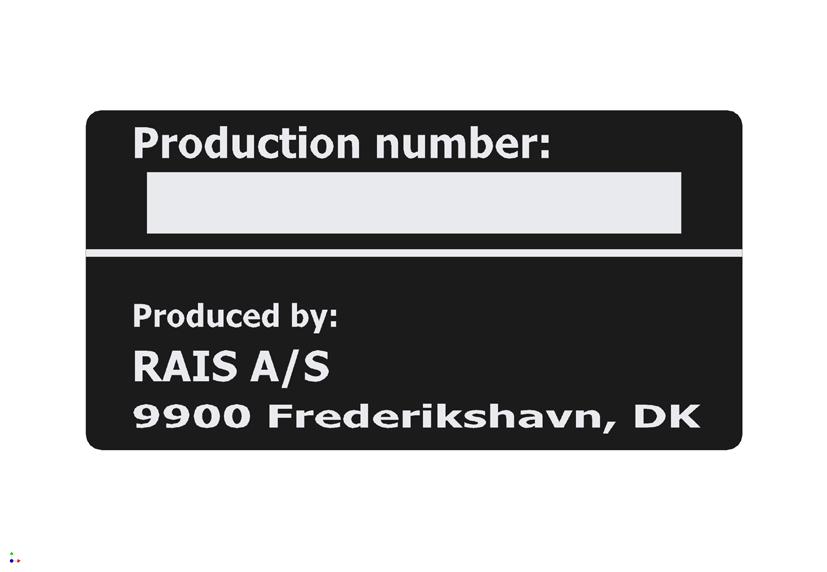
Warranty
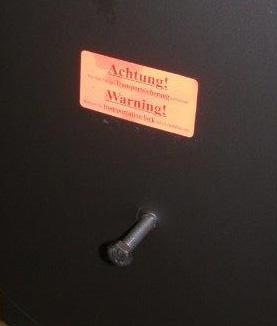
RAIS/attika stoves have been repeatedly tested in terms of the safety and the quality of materials and manufacturing. All models are guaranteed from the date of installation.
The warranty covers:
• documented malfunction due to faulty processing
• proven material defects
The warranty does not cover:
• door and glass gaskets
• ceramic glass
• chamber lining
• appearance of the surface structure or natural stone texture
• appearance or changes of colour of the stainless steel or patina surfaces
• expansion sounds
The warranty becomes void in cases of:
• damage due to overfiring
• damage due to external influences and use of unsuitable fuels
• failure to comply with statutory or recommended installation requirements, and in the case of modifications to the stove.
• lack of service and care
Please contact your dealer in the event of damage. In case of warranty claims, we will determine the most appropriate damage repair procedure. In case of repair, we provide professional implementation.
For warranty claims on supplied or repaired parts refer to national/ EU laws/regulations in connection with renewed warranty periods.
The current warranty conditions can be obtained from RAIS A/S.
Transport safety
Before you install the stove remove the transport safety. There are two screws, one on each side of the stove.
VISIO 2-1 is an inset stove with vertically operated door.
DTIref.:300-ELAB-2241-EN/300-ELAB2241-NS/300-ELAB-2241/300ELAB-2241-DIN+
Danish Technological Institute Teknologiparken Kongsvang Allé 29, DK-8000 Aarhus C
Distances/Measurements
Note that the exhaust branch can rotate continuously.
I: Distance from floor to centre smoke top outlet
K: Distance from back side to air intake bottom (Air System)
N: Distance from side to air intake bottom (Air System)
Convection
RAIS/attika stoves are convection stoves. Convection means that the air is circulated so the heat is more evenly distributed throughout the entire room.
The cold air is sucked in at the base of the stove, and runs along the stove's combustion chamber, whereby air is heated.
The heated air flows out along the sides and out of the top ensuring air circulation
Note that all outer surfaces become hot during the stove's use - extreme care needs to be taken.
Use the insert optimally
By mounting the hot air nozzles and flexible hoses (or similar) on top of the stove, it is possible to "move" the heat to other rooms.
Decisions must be made concerning the positioning of the inlets and outlets of the convection system.
Make sure that the area requirements are respected, and that holes are not blocked from the outside.
Discolouration of the stove walls, doors and convection outlets may occur. This is caused by the rising hot air.
RAIS assumes no responsibility for any installation or consequential damages.
Installation
It is important that the stove is installed properly for the sake of both the environment and safety.
When installing the stove, all local rules and regulations, including those referring to national and European standards must be respected. Local authorities and a chimney specialist should be consulted before installation.
The stove may only be installed by a qualified / competent RAIS dealer / installer or the warranty will be invalid.
It is prohibited to carry out unauthorised alterations to the stove
NOTE!
Before the stove can be used, the local chimney sweep must be notified.
There should be an ample supply of fresh air in the installation room to ensure good combustion- if necessary through an airbox connection . Note that any mechanical exhaust ventilation e.g. an extraction hood may reduce the air supply. Any air vents must be placed in such a manner that the air supply is not blocked. Alternatively, the stove can be supplied with fresh air directly from the outside through a flexible piping fitted to the damper (see Air system section).
The stove consumes 10 to 20 m³of air per hour.
The floor must be able to carry the weight of the stove and the chimney. If the existing floor construction doesn’t meet this requirement, suitable measures (e.g. load distributing plate) shall be taken to achieve it. Consult with a construction expert.
The stove should be placed on non-flammable material. The stove must be placed at a safe distance from flammable materials. It must be ensured that flammable objects (e.g. furniture) are not placed closer than the distances indicated in the following section concerning installation (fire risk).
If the stove is installed on a flammable floor, the size of the non-flammable surface underneath the stove must be in accordance with national / local regulations.
When you choose where you want to place your RAIS /attika stove, you should think of the heat distribution to other rooms. Then you will get the most pleasure from your stove.
See the manufacturer's plate on the stove.
Upon receiving, the stove must be inspected for defects.
For non-flammable materials select panels/brick with a thermal resistance greater than 0.03 m2xK/W. Thermal resistance is defined as the wall thickness (in m) divided by the wall lambda value. Consult your installer/chimney sweep.
During the test the stove was installed in a cabinet made of non-flammable building panels 50 mm Calcium silicate (Super Isol).
Chimney
The chimney is the driving force which makes the stove function. In order for the stove to perform satisfactorily the chimney height must be sufficient to ensure the correct draught of 14 to 18 Pa so as to clear the products of combustion and prevent problems of smoke emanating into the room when firing.
NOTE: A chimney height of not less than 4.5 metres measured vertically from the outlet of the stove to the top of the chimney should be satisfactory. Alternatively the calculation procedure given in BS 5854:1980 may be used as the basis for deciding whether a particular chimney design will provide sufficient draught.
The outlet from the chimney should be above the roof of the building in accordance with the provisions of Building Regulations Approved Document J.
If installation is into an existing chimney then it must be sound and have no cracks or other faults which might allow fumes into the house. Older properties, especially, may have chimney faults or the cross section may be too large i.e. more than 230 mm x 230 mm. Remedial action should be taken, if required, seeking expert advice, if necessary. If it is found necessary to line the chimney then a flue liner suitable for solid fuel must be used in accordance with Building Regulations Approved Document J.
Any existing chimney must be clear of obstruction and have been swept clean immediately before installation of the stove. If the stove is fitted in place of an open fire then the chimney should be swept one month after installation to clear any soot falls which may have occurred due to the difference in combustion between the stove and the open fire.
If there is no existing chimney then either a prefabricated block chimney in accordance with Building Regulations Approved Document J or a twin walled insulated stainless steel flue to BS 1856-1 can be used. These chimneys must be fitted in accordance with the manufacturer’s instructions and Building Regulations.
A single wall metal fluepipe is suitable for connecting the stove to the chimney but is not suitable for using for the complete chimney. The chimney and connecting fluepipe must have a minimum diameter of 180 mm. Any bend in the chimney or connecting fluepipe should not exceed 45°. 90°bends should not be used.
Combustible material should not be located where the heat dissipating through the walls of fireplaces or flues could ignite it. Therefore when installing the stove in the presence of combustible materials due account must be taken of the guidance on the separation of combustible material given in Building Regulations Approved Document J and also in these stove instructions.
If it is found that there is excessive draught in the chimney then either an adjustable flue damper or alternatively a draught stabiliser should be fitted. The adjustable flue damper should not close off the flue entirely but should in its closed position leave a minimum continuous opening free area of at least 20 % of the total cross sectional area of the flue or fluepipe.
Adequate provision e.g. easily accessible soot door or doors must be provided for sweeping the chimney and connecting fluepipe.
You should also familiarise yourself with the draught conditions for chimneys with 2 flues.
The stove is supplied with a ø200 mm flue outlet spigot. The stove is approved with a ø180 mm flue outlet spigot, which can be retrofitted.
Installation measurements for VISIO 2-1
Valid for installation in non-flammable panels (e.g. 50 mm Super Isol), or in brick. If other materials are used, they must have the same or better properties than 50mm Super Isol.
To obtain the necessary distances from the stove to the panel/brickwork, the interior measurements of should be min. 450mm X 1060mm. If these are observed, the exterior can be adjacent to a flammable wall. There must be a top plate in the cabinet which is at least 1800 mm inside from the floor to the underside of the top plate.
A fireplace insert must never be installed too tightly as steel expands during heating.
Hole measurements in the side with elevating gate (height x width) min. 443.5mm x 781mm (int. measurement). Hole measurements are for stove with inset frame.
Hole measurements in the side of the locked door (height x width) min. 443.5mm x 788mm (int. measurement).
Hole measurements are for stove with inset frame.
Minimum distance to flammable materials
A - Distance to furniture 1200mm
B - Distance to flammable floor in front of the oven 300mm
C - Distance to flammable floor next to the oven
E - Distance to flammable side wall 350mm
G - Distance to the floor
H - Distance to ceiling
Minimum distance to firewall
O - Distance to firewall next to stove 200mm
P - Extension of firewall forward
To get the most out of your stove and the best possible flow of warm air out of the convection grilles, place the grates just below the non-flammable top plate. The minimum distance from the top of the top plate to flammable ceiling 250mm
PLEASE NOTE!
The insulated part of the chimney must go all the way down to the flue collar. Clear headroom above the fire chamber min. 512.5 mm.
the stoking door
Convection
There is a minimum requirement for the convection area. This area must be observed due to danger of overheating and due to distance to flammable materials. Make sure that the stove can pull convection air in under the stove. And lead it back out of the stove.
When installed in a completely non-flammable construction, there are no requirements for convection area but it is recommended to transfer the area from the panel construction as the brick work may crack at high temperatures.
Convection area above the stove on instillation must be minimum 1050cm² the area can be distributed over several holes.
Convection area below the stove on instillation
Must be minimum 525cm² the area can be distributed over several holes.
Air system
Mounting the Air-system ensures that the air control system receives fresh air from outside.
To ensure that the Air- system work you have to build it, in such a way, to ensure that there cannot develop low pressure in the home.
If convection grilles are installed, they must not be blocked. Air connection (optional) can be installed underneath the stove.
150 mm flexible hose (metal)
Fuel
The stove has been tested in accordance with DS/EN 13229: 2001, DS/EN 13229: 2001/A1: 2003 DS/EN 13229: 2001/A2: 2004 and NS 3058/3059 for the stoking of split dry birch and approved for hardwood/softwood. The firewood must have a water content of 15-20 % and its maximum length should not exceed 30 cm.
Stoking with wet firewood causes both soot, environmental pollution and bad fuel economy. Freshly cut wood contains approx. 60-70% water, and is completely unsuitable for stoking.
You should allow for, that newly cut wood must be stacked for drying for 2 years. Wood with a diameter of more than 100 mm should be split. Regardless of the size of the wood, it should always have at least one surface area without bark.
It is not allowed to burn lacquered, laminated or impregnated wood, wood with a synthetic surface, painted refuse wood, chipboard, plywood, domestic waste, paper briquettes and pit coal, because it knows malodorous fumes that can be poisonous.
The burning of the above and of amounts larger than those recommended, the stove is subjected to a larger amount of heat, resulting in a higher chimney temperature and lower efficiency. This can result in the stove and chimney becoming damaged and the warranty becoming void.
The calorific value of the firewood is closely connected to the moisture level of the firewood. Moist firewood has a low heat value. The more water the wood contains, the more energy is used to evaporate it and this energy is wasted.
ONLY USE RECOMMENDED FUELS
The following table shows the calorific value of different types of wood which have been stored for 2 years and have a residual moisture content of 15-17%.
Wood Kg dry wood, pr. m3 compared to beech/oak
1 kg of wood yields the same heat energy irrespective of wood type. 1 kg beech merely takes up less space than 1 kg of fir.
Drying and storage
Drying wood takes time. Proper air drying takes approx. 2 years.
Here are some tips:
• Store the wood sawn, split and stacked in an airy, sunny place, which is protected against rain (the south side of the house is particularly suitable).
• Store firewood stacks at a hand's breadth apart, as this ensures that the air flowing through takes the moisture with it.
• Avoid covering the firewood stacks with plastic, as this prevents the moisture from escaping.
• It is a good idea to bring the firewood into the house 2-3 days before you need it.
Regulating the combustion air
All RAIS/attika stoves are equipped with a one-handed operating lever for regulating the damper.
The stove-specific regulating mechanisms can be seen in the diagrams at the front of the manual.
The primary air is combustion air that is added to the primary combustion zone at the bottom of the burning chamber, i.e. the bed of glowing embers. This cold air is only used in the lighting stage.
Secondary air is the air that is added in the gas combustion zone, i.e. air that contributes to the combustion of the pyrolysis gasses (preheated air used for cleaning the glass and combustion). This air is sucked through the damper and preheated via channels in the side/back of the stove and then emitted as hot scavenging air onto the glass. The hot air rinses the glass and keeps it soot-free.
Tertiary air at the back of the burning chamber at the top (row of holes) ensures combustion of the final gas residues/particles before leaving through the chimney.
By setting the interval between position 1 and 2 (see next section) ensures optimum utilisation of the energy content of the wood, as there is oxygen for combustion and for the burning of the pyrolysis gases. When the flames are a clear yellow the damper has been set correctly. Finding the correct position comes with time after regular use of the stove.
We do not recommend to turn it down completely, because it feels too hot. Too little air supply gives poor combustion, which can cause high and dangerous flue gases, emissions and poor efficiency. This results in dark smoke emanating from the chimney, and the calorific value of the wood not used to its fullest.
Ventilation
There must not be an extraction/range hood (kitchen) in the same room as the stove as this may cause the oven to emit fumes into the room.
The stove requires a permanent and adequate air supply to operate safely and efficiently. There can be fitted a permanent air supply vent to the room to the stove's combustion air (see section on Air System).
This air vent should not be shut off or sealed under any circumstances.
Use of the stove
Adjustment of the air dampers - the damper has 3 settings
See diagrams at the front of the manual.
Position 1
Push the lever fully to the left. The damper is closed; there is a minimal air intake. This option should be avoided during normal operation. See warning note after next section.
Position 2
Pull the lever to the right up to the first notch (center position). This position gives only secondary air. During ordinary stoking the lever is set between position 1 and 2. When the flames are clear and yellow, the damper is set correctly - resulting in a slow / optimal burning.
Position 3
Pull the lever to the right.
The damper is fully open and provides full ignition air (primary) and full secondary air. This position is for the lighting stage and refuelling and is not used during normal operation.
First usage
A careful start pays off. Start with a small fire, so that the wood burning stove can get accustomed to the high temperature. This provides the best start and prevents any damage.
Be aware that a strange but harmless odour, as well as smoke from the surface may appear the first time you fire up. This is because the paint and materials need to harden, but the smell disappears quickly - check for good ventilation and draft, if possible.
During this process you must be careful not to touch the exposed surfaces / glass (very hot!). It is recommended that you regularly open and close the door to prevent the door seal from sticking.
In addition, the stove can produce "clicking noises" during heating and cooling, caused by the large temperature differences which the material is exposed to.
Never use any type of liquid fuel for kindling or maintaining the fire. There is a risk of explosion.
If the stove has not been used for a while, follow the steps as if you were using it for the first time.
Lighting and fuelling
PLEASE NOTE!
If air system is connected, the valve must be open.
"Top-Down " lighting (see photos at the front of the manual).
• Open the door completely until it is locked in the open position.
• Start by placing approx. 1kg wood - eg. 2 pieces split wood knot - (Photo 1) in the bottom of the burning chamber. Add approx. 1.2kg dry firewood (Photo 2), split to kindling sticks, loosely on top and 2-3 firelighters or similar.
• Light the fire (photo 3 + 4).
• Set the air damper to pos. 3 (for approx. 15 min.), Then in pos. 2.
• Close the door completely and lift the door handle (air gap of 1-2 cm).
• When the fire has caught the kindling wood, shut the door completely (photo 5) (after approx. 3-10 minutes, depending on the draft conditions in the chimney.
• When the last flames are extinguished and there is a good layer of embers (photo 6), can be filled up to 3-4 pieces of wood - approx. 2-2½ kg (photo 7).
• Shut the door completely.
• If necessary set the air damper to position 3 (far right) for 2-5 min to start the fire (photo 8).
• Adjust the damper between pos. 1 and pos. 2 (see 'Adjustment the air damper').
PLEASE NOTE!
If the fire has burned down too low (too small an ember), it may take longer to get going again. It is recommended to use small pieces of wood to ignite the fire.
When firing the smoke out of the chimney should be almost invisible, just a 'flicker' in the air is observed.
When refuelling, open the door carefully to avoid smoke escaping. Never add wood while there are still visible flames in the oven.
RAIS recommend to refill with 2-4 pieces of wood - approx. 1 ½ - 2 ½ kg - within 49 minutes (intermittent operation).
PLEASE NOTE!
Keep an eye on the stove when lighting.
Keep the door closed during operation. Be careful, as all exterior surfaces become very hot during operation.
Control
Check the stove for signs of proper fireing:
• Ashes appear white
• The walls of the combustion chamber are free of soot
Conclusion: The wood is sufficiently dry.
Advarsel
Advarsel
Warning!!





Hvis brændet kun ulmer eller ryger, og der tilføres for lidt luft, udvikles der uforbrændte røggasser.
If the firewood is only burning slowly without flames or smoking, and too little air is added, unburnt exhaust gases are developed . Exhaust gases may ignite and explode. It can cause damage to equipment and possible human injury.
Røggas kan antændes og eksplodere. Det kan give skader på materiel og i værste fald på personer.
Hvis brændet kun ulmer eller ryger, og der tilføres for lidt luft, udvikles der uforbrændte røggasser. Røggas kan antændes og eksplodere. Det kan give skader på materiel og i værste fald på personer.
Never close the air supply completely when lighting the stove.
Luk aldrig helt for lufttilførslen, når der tændes op i ovnen.
Sample Images
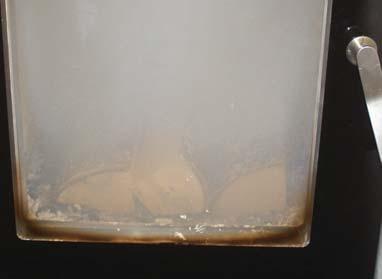
Hvis der kun er få gløder tilbage, skal der tændes op forfra. Hvis man bare lægger brænde på tændes bålet ikke, derimod udvikles der uforbrændte
If there are only a few embers remaining, you must rekindle the fire.
Luk aldrig helt for lufttilførslen, når der tændes op i ovnen. Hvis der kun er få gløder tilbage, skal der tændes op forfra. Hvis man bare lægger brænde på tændes bålet ikke, derimod udvikles der uforbrændte røggasser.
røggasser.
If you simply add firewood, the fire will not be lit, instead, unburned exhaust gasses will develop. Here, firewood has been added to an ember layer that is too small and the air supply is insufficientsmoke is produced.
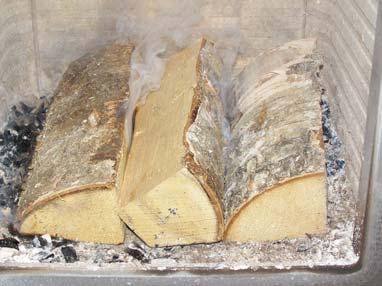
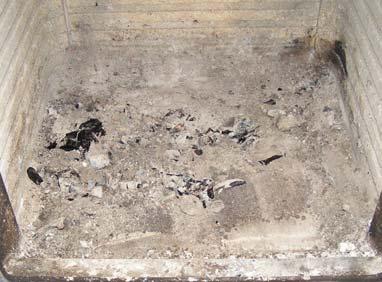
Her er der lagt træ på et for lille glødelag, og der tilføres for lidt luft - røgudvikling begynder.
Her er der lagt træ på et for lille glødelag, og der tilføres for lidt luft - røgudvikling begynder.
Undgå meget kraftig røgudviklingfare for røggaseksplosion.
Undgå meget kraftig røgudviklingfare for røggaseksplosion.
Avoid heavy smoke emissiondanger of exhaust gas explosion.


Ved meget kraftig røgudvikling, åbn luftspjældet helt, samt eventuel låge på klem eller tænd op forfra.
Ved meget kraftig røgudvikling, åbn luftspjældet helt, samt eventuel låge på klem eller tænd op forfra.
In case of very heavy smoke, open the damper fully, open any doors ajar, or light the fire again.
Cleaning and care
Wood stove and chimney must be inspected by a chimney sweep annually. During cleaning and care, the stove must be cold.
If the glass is sooty:
• Clean the glass regularly and only when the stove is cold, otherwise the soot will burn solid.
• Dampen a piece of paper or newspaper, dip it in the ashes and rub the sooty glass.
• Rub with a piece of paper and glass becomes clean.
• Alternatively use glass polish, which can buy from you RAIS distributor.
Clean the exterior with a soft dry cloth or soft brush.
Prior to a new heating season, it should always be checked that the chimney and smoke gas connector are not blocked. Inspect the stove interior and exterior for damage, especially seals and the heat insulating plates (vermiculite).
Maintenance/spare parts
Especially moveable parts are worn down by frequent use. Door seals also become worn. Only use original spare parts. We recommend service performed by your dealer after completion of a heating period.
Combustion chamber lining
The combustion chamber lining protects the body of the wood burning stove against the heat from the fire. the large temperature fluctuations may result in cracks in the plates of the combustion chamber lining, which, however do not affect the functional capacity of the stove. They do not need to be replaced unless long-term use causes them to crumble.
The plates of the combustion chamber lining are only inserting into the stove, and can be easily replaced by your dealer or yourself.
Moving parts
Door hinges and door lock should be lubricated when needed. We recommend to use only our lubricating spray, as the use of other products can lead to the formation of odours and residues. Contact your dealer to obtain the lubricant.
Cleaning the glass door panels - VISIO 2-1
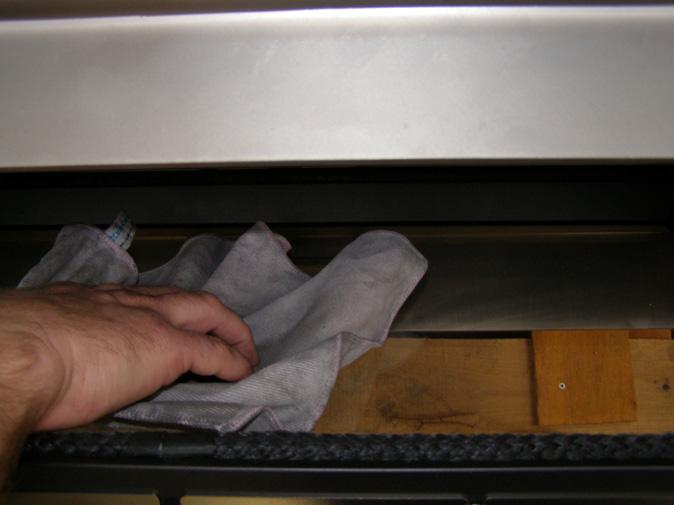
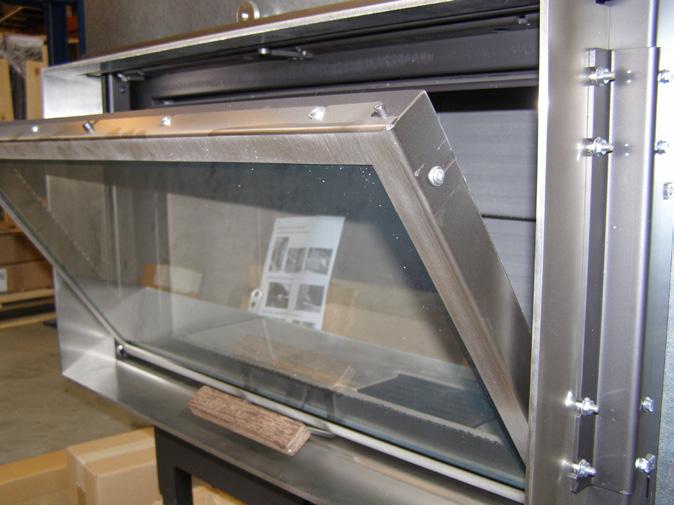
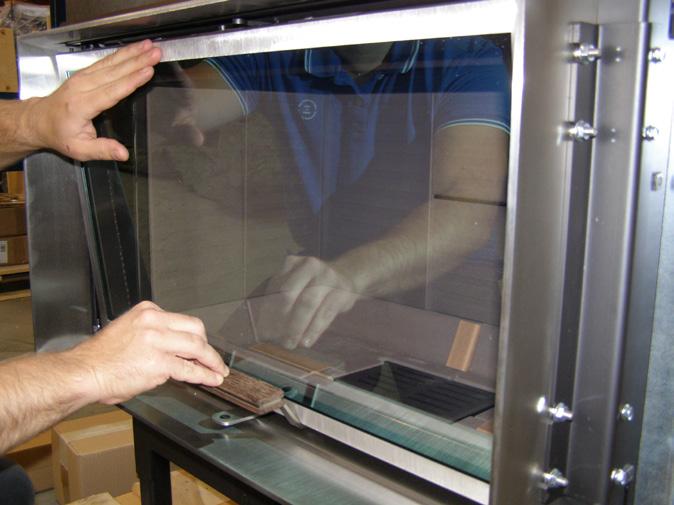
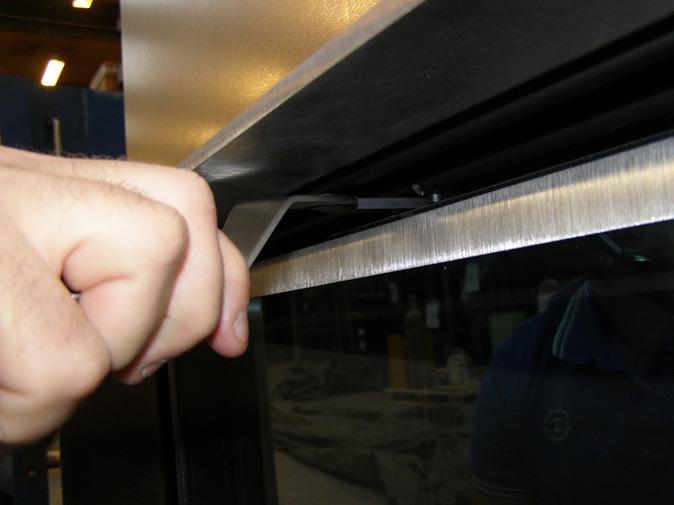
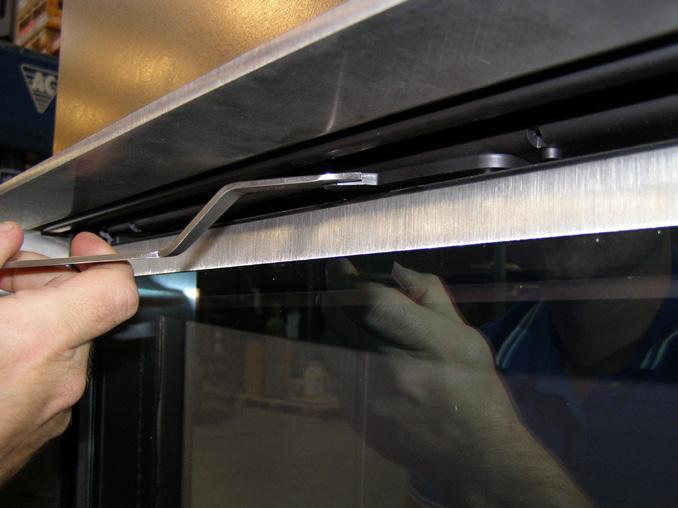
The door is locked in position before cleaning. With the special key supplied with the stove, turn the latch located above the door.
After cleaning, close the door and turn the lock back.
Cleaning the combustion chamber
Scrape/shovel the ashes down into the grate in center of stove. The ash tray under the grill can be removed and emptied into a non-flammable container until it has cooled. You can dispose of ash together with your regular household waste.
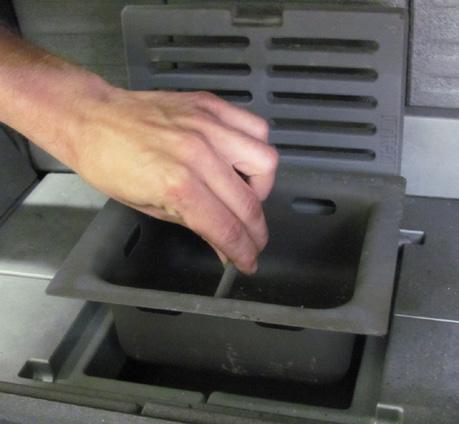
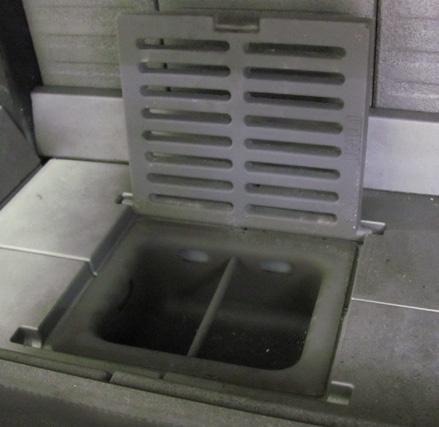
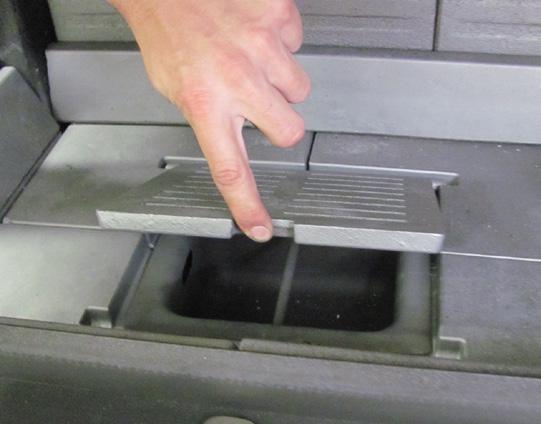
REMEMBER!
• Never remove all the ashes from the combustion chamber
• wood burns best on a layer of ash approx. 20 mm.
Cleaning the flue
In order to gain access the smoke flue, remove the 6 baffle plates made of vermiculite and the 2 smoke chikanes made of sheet steel.
Remove dirt and dust, and mount the parts in reverse order.
PLEASE NOTE!
Be careful when replacing the baffle plates and the smoke chicanes.
Smoke spillage around the door
This may be due to insufficient draft in the chimney <12Pa
• Check whether the flue or chimney is blocked
• Check whether the extraction hood is switched on and, if so, switch it off and open a window / door near the stove for a short period.
Soot on glass
May be caused by
• excessively wet firewood
• the damper regulation is too low
Ensure the proper heating of the stove when firing up, prior to closing the door
Stove is burning too strong
Possible causes
• leak around the door seal
• chimney draft too large> 22 Pa, draft control regulator should be installed.
Stove is burning too weakly
Possible causes
• insufficient amount of wood
• insufficient air supply for room ventilation
• unclean smoke channels
• leaky chimney
• leakage between chimney and flue
Low draught in the chimney
Possible causes
• temperature difference too small, e.g. due to poorly insulated chimney
• outside temperature is high, e.g. in the summer
• no wind
• the chimney is too low and sheltered
• false air draught in the chimney
• chimney and flue pipe is blocked
• the house is too dense (lack of fresh air intake).
• negative smoke extraction (poor draft conditions)
In the case of a cold chimney or difficult weather conditions you can compensate by adding more air to the stove than usual.
If your stove continues to malfunction, we recommend that you contact your RAIS distributor or chimney sweep.
WARNING!
If incorrect, or too damp firewood is used, it can lead to excessive formation of soot in the chimney and, possibly a chimney fire:
• In this case, shut off for all air supply to the stove. If the system has a valve connection - air connection from the outside, it must also be closed.
• call the fire department
• neveruse water to put out the fire!
• Afterwards, you should ask your chimney sweep to check the stove and chimney
IMPORTANT!
• to ensure safe burning, there must be clear yellow flames or clear embers
• the firewood should not be smouldering.
If the firewood is only burning slowly without flames or is smoking, and too little air is added, unburned fumes will develop. Flue gasses can ignite and explode. It can cause damage to equipment and possible human injury.
Never close the air supply completely when lighting the stove.














